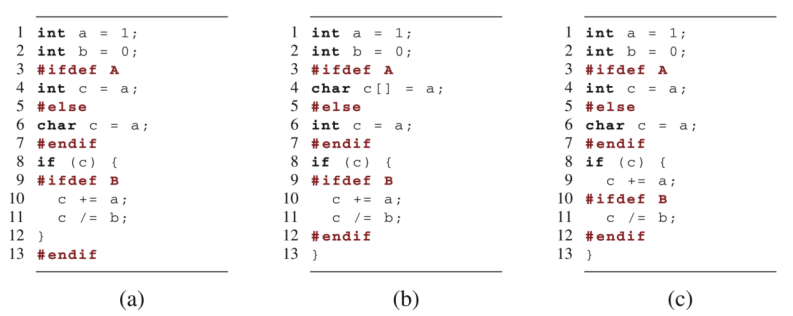Question
1. Consider annotation-based and composition-based variability representation. a. Define each and note how they differ from each other. b. Explain potential advantages and disadvantages of
1. Consider annotation-based and composition-based variability representation. a. Define each and note how they differ from each other. b. Explain potential advantages and disadvantages of each. 2. The following three code segments (in Java) use preprocessor-based implementation.
 a. Locate and explain all errors in the code of each of the three segments (hint: these may not be due to misuse of preprocessor statements, and there may be multiple errors). State any assumptions you are making about the operation of these programs.
a. Locate and explain all errors in the code of each of the three segments (hint: these may not be due to misuse of preprocessor statements, and there may be multiple errors). State any assumptions you are making about the operation of these programs.
b. Identify the features that would lead to these errors being detected if selected or unselected.
a; 11 1 int a = 1; 2 int b = 0; 3 #ifdef A 4 int c = a; 5 #else 6 charc a; 7 #endif 8 if (c) { 9 #ifdef B 10 C += 11 c/ = b; 12 ) 13 #endif 1 int a = 1; 2 int b = 0; 3 #ifdef A 4 char C[] = 5 #else 6 int c = a; 7 #endif 8 if (c) { 9 #ifdef B 10 C += a; 11 C/ = b; 12 #endit 13) 1 int a 1; 2 int b = 0; 3 #ifdef A 4 int c = a; 5 #else 6 char c = a; 7 #endit 8 if (c) { 9 C + = a; 10 #ifdef B 11 C/ = b; 12 #endif 13) ai (a) (b) (c) a; 11 1 int a = 1; 2 int b = 0; 3 #ifdef A 4 int c = a; 5 #else 6 charc a; 7 #endif 8 if (c) { 9 #ifdef B 10 C += 11 c/ = b; 12 ) 13 #endif 1 int a = 1; 2 int b = 0; 3 #ifdef A 4 char C[] = 5 #else 6 int c = a; 7 #endif 8 if (c) { 9 #ifdef B 10 C += a; 11 C/ = b; 12 #endit 13) 1 int a 1; 2 int b = 0; 3 #ifdef A 4 int c = a; 5 #else 6 char c = a; 7 #endit 8 if (c) { 9 C + = a; 10 #ifdef B 11 C/ = b; 12 #endif 13) ai (a) (b) (c)Step by Step Solution
There are 3 Steps involved in it
Step: 1

Get Instant Access to Expert-Tailored Solutions
See step-by-step solutions with expert insights and AI powered tools for academic success
Step: 2

Step: 3

Ace Your Homework with AI
Get the answers you need in no time with our AI-driven, step-by-step assistance
Get Started


